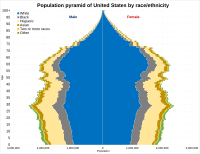
Photo from wikipedia
INTRODUCTION Previous analyses suggest that ethnic and racial differences exist in acute stroke care including thrombolytic treatment rates. The current study evaluates ethnic or racial differences in acute stroke treatment… Click to show full abstract
INTRODUCTION Previous analyses suggest that ethnic and racial differences exist in acute stroke care including thrombolytic treatment rates. The current study evaluates ethnic or racial differences in acute stroke treatment within a multi-state telestroke program. METHODS Acute telestroke consultations seen in the Emergency Department in 203 facilities and 23 states were extracted from the Telecare by TeleSpecialistsTM database. Cases were reviewed for age, race, ethnicity, sex, last known normal time, arrival time, treatment with thrombolytic therapy, door-to-needle (DTN) time, and baseline National Institutes of Health Stroke Scale score. Race was defined as Black, White, or Other; ethnicity was defined as Hispanic or non-Hispanic. RESULTS The current study included 13,221 acute telestroke consultations consisting of 9890 White, 2048 Black, and 1283 patients classified as Other. A total of 934 patients were Hispanic and 12,287 patients were non-Hispanic. There were no statistically significant differences noted in thrombolytic treatment rates when comparing White (7.9%) patients with non-White patients (7.4%), p = 0.36, or comparing Black (8.1%) with non-Black patients (7.8%), p = 0.59. In addition, there were no statistically significant differences in treatment rates comparing Hispanic (6.3%) with non-Hispanic (7.9%) patients, p = 0.072. We noted no measurable differences in DTN times by race or ethnicity. CONCLUSIONS Contrary to previous reports, we failed to detect any significant differences in thrombolytic treatment rates and DTN times by race or ethnicity among stroke patients in a multistate telestroke program. These findings support the hypothesis that telestroke may mitigate racial and ethnic disparities which may be attributable to local variability in stroke procedures or access to healthcare.
Journal Title: Journal of telemedicine and telecare
Year Published: 2023
Link to full text (if available)
Share on Social Media: Sign Up to like & get
recommendations!